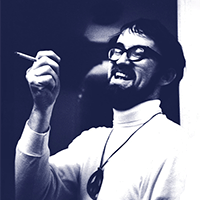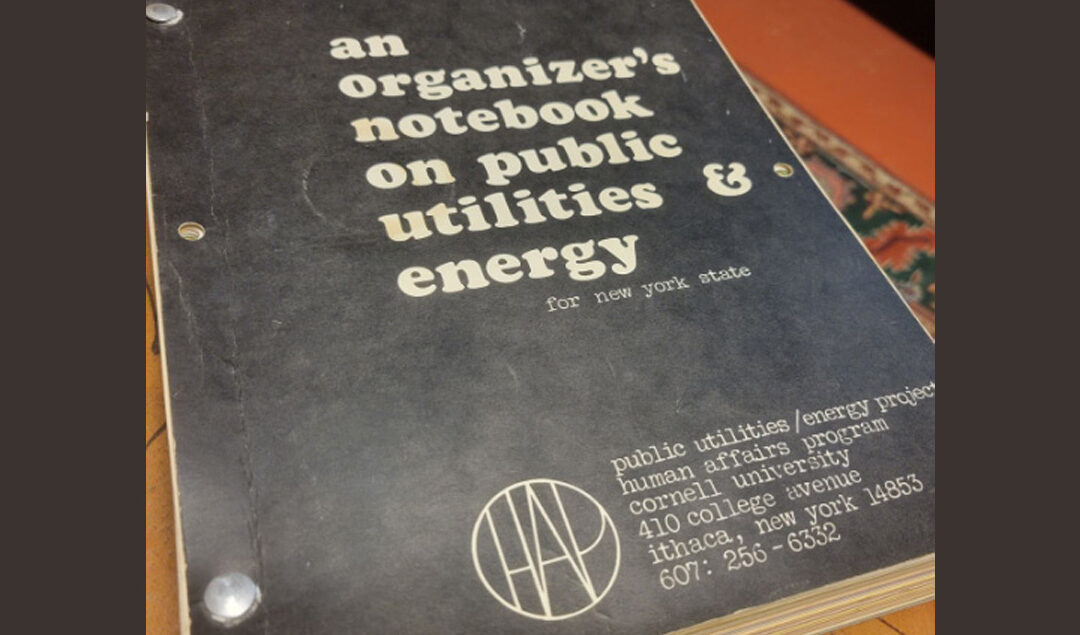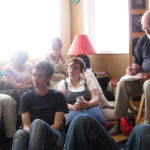The Human Affairs Program began in 1969. Its mission was to combine active learning and concrete involvement with poor and working people in New York’s Southern Tier region. According to the job announcement I responded to, the program “emphasizes three goals: learning through active program solving, the development of widespread community control and the constant examination of education and the role of the highly educated in the struggle for social justice.”
In April, 1969, students with the Afro-American Society took over Cornell’s Willard Strait Hall in response to a cross burning and the University’s slow progress on establishing a black studies program. When they were attacked by fraternity students, they armed themselves. When they ended their occupation 36 hours later, they left the building showing their rifles and bandoleers. A Pulitzer Prize winning photo of that exit appeared in newspapers across the country.
Cornell responded by establishing new centers, like the Afro-American Studies Center under the direction of James Turner. It also entered into a several year discussion and experimentation between 1969 and 1971 about how to create a college or a program of applied human affairs led by a famous Professor based in the College of Industrial and Labor Relations, William Foote White. All of this led to the establishment of the Human Affairs Program (HAP) as an independent center, first funded by a grant from the New World Foundation and then, on a very modest scale, by the University itself.
HAP attempted to serve several constituencies. For the faculty that sponsored HAP sections, HAP served as a field study education center and an entry into the broader community. For Cornell students, graduate or undergraduate, it got them out of the classroom for one year, and earning credit through engagement in a particular community project headed by a HAP staff person. For radical pedagogues, HAP provided a place for educational experimentation. For many of the staff, HAP was a way to deliver services to the poor.
By the fall of 1973, Ben Erlich headed the Community Development project in Elmira, New York. Becky Fowler ran HAP’s Storefront project in downtown Ithaca that supported tenant and welfare rights organizations and acted as a social service center for poor people. Sam Salkin ran the Blue Bus, a mobile project providing help to the rural poor in the New York section of the Appalachian Mountains. Frankie Whitman organized around food cooperatives. Nancy Bereano worked on women’s issues, as did the youngest staff member, Bernice Cramer. Mike Wright headed the Criminal Justice project working with prisoner groups in the Elmira prison.
When I became the first full time Director in the summer of 1973 and made Jinx Dowd the Assistant Director, I came into conflict with some of the staff almost immediately. My fourteen thousand dollar salary was twice what other staff were paid. They all made around six thousand. They wanted me to share. I told them I would make a list of all my income and assets and I wanted them to do likewise. When all the data was in, we’ll meet and divide things up. I suggested that the distribution would flow in my direction. They didn’t bring the issue up again. I didn’t like liberals pretending to be poor.
The political environment was in transition in the mid 1970s. The heyday of LBJ’s war on poverty was coming to a close. The Vietnam war stole all the funds and now it too came to an end. The New York Times announced the end of the student movement. Anti-war activists tried to redirect their energies, but in what direction?
I was an organizer, not a service provider. I didn’t want to sit around on the HAP office floor all day long talking and searching for a false consensus, pretending I was poor, or a victim of oppression. I brought in tables and chairs, prepared agendas and organized staff meetings with time limits. I hustled money from Cornell, gave the office a new paint job, outfitted the office with functional typewriters and developed a work plan for resource staff and new directions. There were things to do and time was wasting.
When one staff person told me she didn’t need to show up to her class, I asked her why. She said the point of alternative education was to see what the students would do when there was no instructor. I fired her even though she was a single mother to a whole bunch of radical kids well known in the Ithaca community.
Over the next year, 1973-1974, I proposed a plan that shifted the HAP program from a service orientation to an organizing model based on analyzes of key institutions in New York State. I wanted to go after the private electric monopolies, the banks, the major corporations and prison industries and build statewide coalitions to challenge their practices and their existence. A good portion of the HAP staff was not interested and opposed this shift.
Internal political fights are the worst. Finding an enemy and focusing all your collective energy on that target is so much better. But it came down to an internal political fight at HAP and I took it on. I believed in my vision and the need to get out of the “poverty organizing” framework. The conflict divided the HAP staff almost down the middle, but I organized a majority to create the new positions and get rid of the old ones. Staff members mobilized their community constituencies and pulled on their personal loyalties. You have to be young and a believer to engage in these types of fights. I was both.
When it came down to the staff meeting vote, my side wore red t-shirts under their normal wear and we secretly showed the top of our red t-shirt to each other as we entered the extremely tense room. To make a long story short, I won the vote and in the spring of 1974 I fired about half the staff by eliminating their positions.
I remember going to Cornell University’s Personnel Director. He was known as an anti-union, right winger, but he gave me good advice about firing. Do it carefully, but quickly. No tentative moves. It’s over and final. Sorry. I almost followed his advice. I arranged meetings with all the people I was going to fire on the same day at staged intervals so that I could get it all done before the first one could tell the last one. I did, however, say that they could stay over the summer as a transition period. That was a mistake. They caused me nothing but trouble while they finished out their employment.
In the summer of 1974, I began a national recruitment campaign to hire new folks. Jinx and I hired eight people over a three month period: Bob Fitch, David Olson, Lin Farley, Karen Sauvigne, Susan Meyer, Jim Schmidt, Larry Reverby and Tonya Prattis. By the time the hiring was done, I was exhausted.
Although formally the Director, I let the collective decision-making ethic of the time get to my head. Part of it was, now that I had hired all these radicals I thought it was up to them to create their projects. I even let the new staff design a program brochure that didn’t mention that I was Director. This led to an everyone-doing-their-own-thing type of organization rather than a collective organizing effort.
Nevertheless, for the next two years until Cornell terminated the program in June, 1976, we did some great organizing and much of it continued after Cornell got rid of us.
A main organizing focus at the HAP program was “Women and Work.” I hired Lin Farley to build upon the initial work of Bernice Cramer and then hired Karen Sauvigne and Susan Meyer to provide back up research. Lin was a tough and determined woman focused on the working class who proposed and implemented a “Speak Out” for women only on their experiences at work. The University objected to this “closed” meeting sponsored by HAP as a violation of the Academy’s principle of open discussion. I pointed out that Cornell’s Board of Trustee meetings were also closed and Lin proceeded with the Speak Out.
Lin, Karen and Susan took that Speak Out experience and built Working Women United, published a Women’s newsletter, Labor Pains, printed a “Working Women’s Guide to Tompkins County,” established a Legal Defense Fund for women and created a Working Women United Institute, a not for profit that continued the work after HAP was terminated.
Lin took the research and the survey she conducted at the Speak Out and wrote her book, Sexual Shakedown. All of their ground-breaking work led to the definition and recognition of the term “sexual harassment” in the American workplace.
Another major issue in the mid-70s in New York state was the loss of manufacturing jobs, its relationship to the high cost of electrical energy and its relationship to nuclear power plants. Jim Schmidt, Jinx Dowd and I focused on this work.
Jim hustled a $20,000 grant from OEO to fund energy education workshops and we ran all over New York from Albany to Buffalo putting on these workshops. We pointed to local municipal power with hydroelectric energy from the Power Authority of the State of New York (PSNY) as the solution.
We also developed a particular conference technique. We structured conferences so the end product was an in-place organization. We did this when we created the People’s Power Coalition of New York (PPC), linking nuclear power opponents and ratepayer groups. We also did this when we created the Labor Action Coalition of New York (LAC) dedicated to “safe energy, full employment and public power.” Jim Schmidt staffed the PPC until it had sufficient funds to become independent. Jinx Dowd and I staffed the LAC and Jinx remained the lead staff for years after the HAP program was terminated.
The guy that wanted us to organize something for labor was Ed Bloch. Ed was an organizer from the United Electrical (UE) union based in Hudson Falls, New York. Ed was my introduction to organized labor, its history and internal dynamics. He was also our guide to the construction of the LAC which grew to be 40 plus local industrial unions like the IAM and UAW across New York state. He taught us the difference between a rank and file controlled union and one dominated by staff, the difference between an industrial CIO union and an AFL craft union, the importance of labor education in places like the UAW’s Walter and Mae Reuther Family Education Center and how labor lost its own political voice in the post WWII red scare. Ed’s tutoring during this time made it possible for me to bring organized labor into the Citizen Party formation in 1979-1980 and gave me the background to organize a Labor Education Center at The Evergreen State College in 1987.
The best examples of the HAP staff working collectively on a project was the creation, publication and distribution of a massive eight and a half by eleven book called, “An Organizer’s Notebook on Public Utilities and Energy.” The original research in the notebook was done by HAP staff. Bob Fitch wrote about the private utilities and public power. Dave Olsen analyzed the banks interlocked with the utilities. Larry Reverby analyzed the proposed super electric monopoly. Lin Farley contributed her essays on decision-making and group facilitation and I presented my “Framework for Organizing.” To all this original research, we added the work of local labor and environmental activities, research guidelines and contact information for community organizations across the state.
All of this work on private monopolies, their banks and our support for campaigns to take over private electric utilities and create municipally owned electric systems, led to an emergency meeting of my Board in the winter of 1975. The Board of the Human Affairs Program was composed of the Deans of the Colleges who typically sent students to the HAP program.
When the meeting opened, the Corporation Counsel for Cornell University said he didn’t know what “this utility project was”, but I needed to “sterilize it.” The liberal Dean on the Board said that he wrote to Niagara Mohawk, the largest upstate electric utility, and asked what they had done for Cornell University lately. He said they wrote back. Turns out they had done “quite a bit and I needed to get rid of the utility project.”
Of course, when I told the bunch of radicals on my staff what Cornell wanted, they all said, in effect, screw Cornell. This led to a one page press release from Cornell terminating the Human Affairs Program by June, 1976. We had all lost our jobs.



